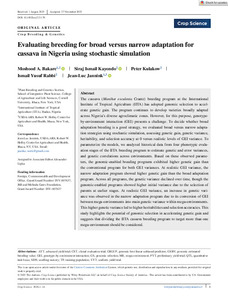| dc.contributor.author | Bakare, M.A. |
| dc.contributor.author | Kayondo, S.I. |
| dc.contributor.author | Kulakow, P. |
| dc.contributor.author | Rabbi, I.Y. |
| dc.contributor.author | Jannink, J.L. |
| dc.date.accessioned | 2024-03-14T08:06:23Z |
| dc.date.available | 2024-03-14T08:06:23Z |
| dc.date.issued | 2024 |
| dc.identifier.citation | Bakare, M.A., Kayondo, S.I., Kulakow, P., Rabbi, I.Y. & Jannink, J.L. (2024). Evaluating breeding for broad versus narrow adaptation for cassava in Nigeria using stochastic simulation. Crop Science, 1-14. |
| dc.identifier.issn | 0011-183X |
| dc.identifier.uri | https://hdl.handle.net/20.500.12478/8437 |
| dc.description.abstract | The cassava (Manihot esculenta Crantz) breeding program at the International Institute of Tropical Agriculture (IITA) has adopted genomic selection to accelerate genetic gain. The program continues to develop varieties broadly adapted across Nigeria’s diverse agroclimatic zones. However, genotype by- environment interaction (GEI) presents a challenge for this purpose. To decide whether broad adaptation breeding is a good strategy, we evaluated broad versus narrow adaptation strategies using stochastic simulation, assessing genetic gain, genetic variance, heritability, and selection accuracy at 0 versus realistic levels of GEI variance. To parameterize the models, we analyzed historical data from four phenotypic evaluation stages of the IITA breeding program to estimate genetic and error variances, and genetic correlations across environments. Based on these observed parameters, the genomic-enabled breeding programs exhibited higher genetic gain than the conventional program for both GEI variances. At realistic GEI variance, the
narrow adaptation program showed higher genetic gain than the broad adaptation program. Across all programs, the genetic variance declined over time, though the genomic-enabled programs showed higher initial variance due to the selection of parents at earlier stages. At realistic GEI variance, an increase in genetic variance was observed in the narrow adaptation program due to its conversion of GEI between mega-environments into main genetic variance within mega-environments. This higher genetic variance led to higher heritabilities and selection accuracies. This study highlights the potential of genomic selection in accelerating genetic gain and suggests that dividing the IITA cassava breeding program to target more than one mega-environment should be considered. |
| dc.description.sponsorship | Foreign, Commonwealth and Development Office, United Kingdom |
| dc.description.sponsorship | Bill & Melinda Gates Foundation |
| dc.format.extent | 1-14 |
| dc.language.iso | en |
| dc.subject | Cassava |
| dc.subject | Breeding |
| dc.subject | Genomics |
| dc.subject | Genotypes |
| dc.title | Evaluating breeding for broad versus narrow adaptation for cassava in Nigeria using stochastic simulation |
| dc.type | Journal Article |
| cg.contributor.crp | Roots, Tubers and Bananas |
| cg.contributor.affiliation | Cornell University |
| cg.contributor.affiliation | International Institute of Tropical Agriculture |
| cg.coverage.region | Africa |
| cg.coverage.region | West Africa |
| cg.coverage.country | Nigeria |
| cg.coverage.hub | Headquarters and Western Africa Hub |
| cg.researchtheme | Biotech and Plant Breeding |
| cg.identifier.bibtexciteid | BAKARE:2024 |
| cg.isijournal | ISI Journal |
| cg.authorship.types | CGIAR and advanced research institute |
| cg.iitasubject | Agronomy |
| cg.iitasubject | Cassava |
| cg.iitasubject | Food Security |
| cg.iitasubject | Genetic Improvement |
| cg.iitasubject | Plant Breeding |
| cg.iitasubject | Plant Production |
| cg.journal | Crop Science |
| cg.notes | Open Access Article |
| cg.accessibilitystatus | Open Access |
| cg.reviewstatus | Peer Review |
| cg.usagerightslicense | Creative Commons Attribution 4.0 (CC BY 0.0) |
| cg.targetaudience | Scientists |
| cg.identifier.doi | https://doi.org/10.1002/csc2.21170 |
| cg.iitaauthor.identifier | Moshood Agba Bakare: 0000-0003-1910-8233 |
| cg.iitaauthor.identifier | Kayondo Siraj Ismail: 0000-0002-3212-5727 |
| cg.iitaauthor.identifier | Peter Kulakow: 0000-0002-7574-2645 |
| cg.iitaauthor.identifier | Ismail Rabbi: 0000-0001-9966-2941 |
| cg.futureupdate.required | No |

